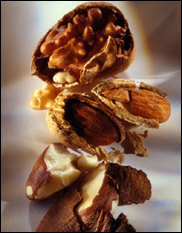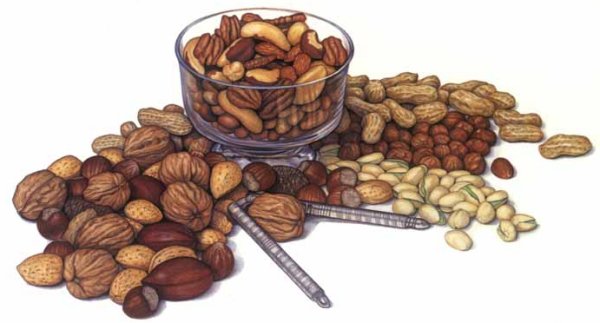
Greeks: Nuts About Nuts -- Diane Kochilas ***
In Sweets The use of nuts in Greek pastry making is not limited to the well-known fillo dessert baklava. Since time immemorial, Greeks have enjoyed the intoxicating combination of nuts and honey, especially walnuts and honey. Today, that combination is still popular and so high in calories and energy, it is thought to be an aphrodisiac! In ancient Greece, sweetmeats that must have resembled the nut brittles of today seem to have abounded. Today, nut-based sweets include a whole bevy of preparations from all over the country. In fact, even the commonplace baklava comes in myriad versions, some prepared with almonds, some with walnuts, some with pistachios, some with pine nuts, and some with combinations of all the above. Baklava is generally prepared in whole sheet pans. The distinguishing regional feature, besides the variety of nuts used, is the height—as determined by the number of fillo layers and the quantity of nuts used in the filling. Desserts similar to baklava, that is, fillo desserts that call for nuts, include a whole range of shapes, from cylindrical finger-sized logs filled with nuts to little coils in which the center is speckled with nuts, to something akin to an open beggar’s purse, again with nuts in the center.
In pastry, though, nuts find their place well beyond the spectrum of fillo. One of the best-loved winter sweets is the delicious, spiced karydopita, or walnut cake, a rich cake in which ground nuts are used almost as flour, mixed in to lend texture and density to the recipe, which is then baked and soaked in a light syrup. Nuts form the basis of some of Greece’s best cookies, too, especially the crisp, melt-in-your mouth kourambiedes, a kind of shortbread cookie made from blanched, ground almonds and dusted with powdered sugar; and the melomakarona, often either topped with ground walnuts or filled with them, and dipped in honey syrup. Both of these are classics on the Greek Christmas table. Another interesting nut-based cookie comes from the island of Corfu and is called moustatsonia. Basically these are flourless little flat cookies made with ground almonds, eggs, sugar and vanilla. Unlike the more common kourambiedes, they are not dusted with sugar but enjoyed as is. Nuts— especially ground walnuts—find their way onto the crisp, fried dough fritters known as thiples, too. My favorite sweetmeats based on nuts, though, are the sugar-dusted white confections found all over the Greek islands. These macaroon-like preparations are generally made with blanched, ground almonds, sugar, egg whites (not always) and either rose water, orange blossom water or liqueur (especially orange). They are really a kind of rough-textured marzipan, often shaped into tiny droplets or pears or balls, often (but not always) baked. They usually go by the name amygdalota. Those found on the island of Andros are said to be among the best, but there are many such sweets made all over the country. Perhaps the most unusual use of nuts in Greek dessert making is found in the many preserved nut recipes. These generally fall under the category of spoon sweets. They hark back to the ancient predilection for nuts and honey, but are generally quite different. Instead, these preserved nuts call for young, immature nuts, especially pistachios and walnuts that are still encased in their downy green shells. These are preserved in a sugar syrup, sometimes spiced with the likes of cloves or cinnamon. Pistachio spoon sweet is a specialty of Aegina, where the best pistachios in Greece are grown. The walnut spoon sweet, though, is one of the most exotic in the whole bevy of Greek preserves. The walnuts have to be soaked for around 40 days. They change color and become pitch black. At this point, they are ready to be preserved in syrup. The result is an absolutely intoxicating dessert, and one of the most traditional —and more and more obscure—in the whole Greek sweets repertory. In Savory Dishes It might seem odd to have begun this foray into nuts with their use in Greek pastry and desserts, but that is, indeed, where one finds them the most in the Greek kitchen. However, when nuts do appear in savory dishes, they make for some of the most unusual and interesting preparations in all of Greek cuisine. Nuts are used as thickeners and bases in sauces and dip-like dishes. Almonds often appear in regional preparations of taramosalata, the Greek fish-roe spread. Their use in this dish lends it a lovely, creamy, mild texture with none of the gumminess that sometimes results from using potatoes or dried bread as a base. Skordalia—the well-known garlic spread—also sometimes calls for almonds, but walnuts are the preferred nut especially in Greece’s northern capital, Thessaloniki. Pine nuts are also sometimes used in both these preparations, but are much less prevalent mainly because they tend to be quite costly. One of the most interesting nutbased dishes is a garlicky walnut sauce that is prepared with seafood and river fish in the northwestern reaches of Greece and not found anywhere else. A similar garlicky walnut sauce is also sometimes served with rabbit in the Peloponnese. One of my own favorite dishes and one I consider to be the epitome of Greek comfort food is a luscious hearty dish of stewed chicken served with noodles simmered in broth and topped with ground walnuts. It comes from Thessaly in the central mainland. Walnuts, pine nuts, chestnuts and almonds all find their way into myriad stuffings in the Greek kitchen, too. Walnuts, combined with tomatoes and onions, are found in one of the country’s most unique savory pies, a recipe from Naoussa. Clearly, the nuts give weight and texture to the dish, and, once baked, the filling resembles ground meat so much that one can hardly tell that it isn’t. This use as an ersatz “ground meat” might also explain its appearance in another very distinct regional dish, a ground-walnut-filled miniature omelet from the island of Chios in the eastern Aegean. Christmas turkey is filled with a lovely chestnut and rice stuffing, as are several Easter preparations from the Aegean islands. A whole array of rice-stuffed dishes utilizes nuts, from pine-nut-and-rice-stuffed grape leaves, a classic of Greek cuisine, to all manner of vegetables stuffed with rice and nuts. Pilafs also call for the addition of various nuts. One of my favorites is a dish from the Greek diaspora, namely from the Greeks who emigrated from around the Caucasus. They prepare a lovely bulgur pilaf with ground walnuts and parsley which is very healthful, refreshing and filling.
|
|


